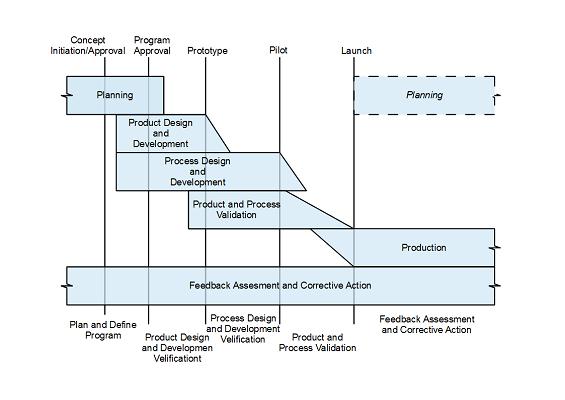Quality - Advanced Product Quality Planning (APQP)
APQP or Advanced Product Quality Planning is a quality framework developed by a commission of experts gathered from Ford, General Motors and Chrysler. This framework is used by Organizations for developing their new products.
The process as described in the AIAG manual 810-358-3003 was initially designed to suit the requirements of the Automotive Industries. But today, it is applied to many industries in the manufacturing domain and is similar to the various concepts used in of Design for Six Sigma.
The goal of this framework is to “Design the product as per the customer needs”. This is achieved through
- Upfront /Proactive Quality Planning.
- Validating against the customer requirements and its continuous improvement.
The picture above depicts the various phases involved in the APQP process.
APQP consists of Five Phases and Five Activities as mentioned below
Phases
- Plan and Define Program
- Product Design and Development Verification
- Process Design and Development Verification
- Product and Process Validation
- Launch, Feedback, Assessment & Corrective Action
Activities
- Planning
- Product Design and Development
- Process Design and Development
- Product and Process Validation
- Production
Plan and Define
The Question Addressed in this phase is “What is it that the customer wants?” The customer needs and wants are used to define the Quality Program.
This stage ensures that the Customer needs are well understood and the Product being designed will satisfy their needs.
The Inputs to this phase are as follows:
- Voice of the Customer
- Market Research
- Historical Warranty and Quality Information
- Team Experience
- Business Plan/Marketing Strategy
- Product/Process Benchmark Data
- Product/Process Assumptions
- Product Reliability Studies
- Customer Inputs
Based on the inputs following are the outputs from this phase.
- Design Goals
- Reliability and Quality Goals
- Preliminary Bill of Material
- Preliminary Process Flow Chart
- Preliminary Listing of Special Product and Process Characteristics
- Product Assurance Plan
- Management Support
Product Design and Development
The Question Addressed in this phase is “How do we design the Product?”
In this phase the design features and characteristics are designed to its final form. The Inputs to this stage is the Outputs from planning phase. All the design factors are considered and a prototype is built to validate whether it meets the customer requirements.
A Prototype Build Control Plan is made for the purpose. The designed product must take into consideration the various aspects of such as the production volumes and schedules, investment, quality, reliability, weight, timing etc. This phase that a preliminary feasibility analysis is done and hence eliminates the potential failures that may arise during manufacturing.
Based on the inputs from the previous stage following are the outputs
- Design Failure Mode and Effects Analysis (DFMEA)
- Design for Manufacturability and Assembly
- Design Verification
- Design Reviews
- Prototype Build - Control Plan
- Engineering Drawings (Including Math Data)
- Engineering Specifications.
- Material Specifications
- Drawing and Specification Changes
- New Equipment, Tooling and Facilities Requirements
- Special Product and Process Characteristics
- Gages/Testing Equipment Requirements
- Team Feasibility Commitment and Management Support
Process Design and Development
The Question Addressed in this phase is “How do we manufacture this Product?”
This phase results in the necessary Manufacturing system and control plans to achieve the quality product. The manufacturing system hence designed must ensure that the customer requirements are met. The inputs are the outputs of the Product design phase and will result in the following output.
- Packaging Standards
- Product/Process Quality System Review
- Process Flow Chart
- Floor Plan Layout
- Characteristics Matrix
- Process Failure Mode and Effects Analysis (PFMEA)
- Pre-Launch Control Plan
- Process Instructions
- Measurement Systems Analysis Plan
- Preliminary Process Capability Study Plan
- Packaging Specifications
- Management Support
Product and Process Validation
The Question asked in this phase is “Have we designed the right product and process?”
The Manufacturing process and the Product are validated in this phase. The Product Quality Planning team is responsible for validating whether the control plan is being followed and that the Product satisfies the customer. A Production trial run is done with the “to be used production equipment, tooling, machinery, operators and cycle time settings for manufacturing the product.
It will result in a feasibility report illustrating the suitability of the system and the concerns if any that should be taken into account before going ahead with the actual run.
Following are the outputs of this phase.
- Production Trial Run
- Measurement Systems Evaluation
- Preliminary Process Capability Study
- Production Part Approval
- Production Validation Testing
- Packaging Evaluation
- Production Control Plan
- Quality Planning Sign-Off and Management Support
Feedback Assessment and Corrective actions
In this phase the output of the Validation phases are evaluated. The entire process of APQP is customer centric and ensures that its requirements are met. The variable and attribute data is evaluated. It is also verified that the Special characteristics are manufactured within the required limits. Appropriate actions are taken if the results do not match with the customer requirements. It is an obligation for every person in the value chain to meet the customer requirements at all characteristics. Following are the outputs of this phase:
- Reduced Variation
- Customer Satisfaction
- Delivery and Service
